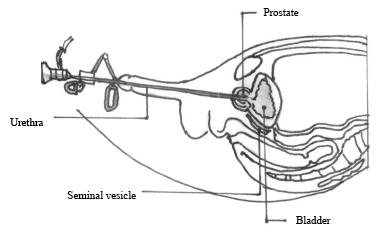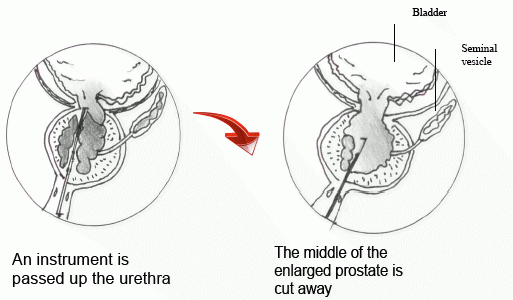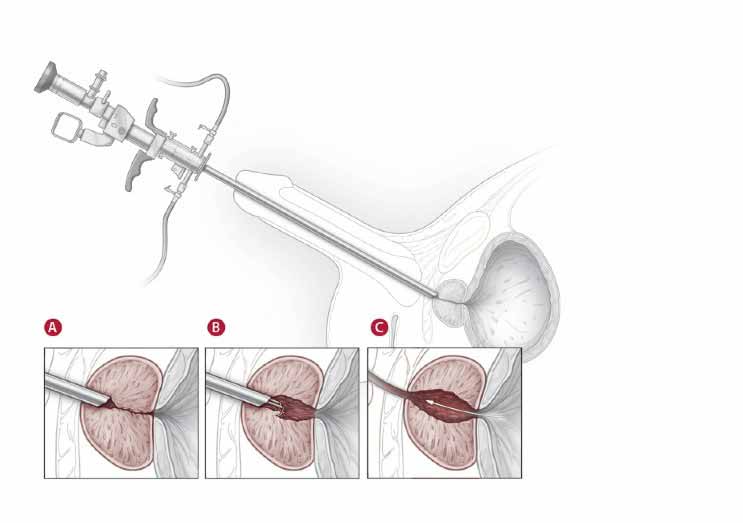A TURP is an operation to treat urinary blockage caused by enlargement of the prostate. The procedure removes the part of the prostate gland that surrounds the urethra and causes obstruction to the urethra as a result of Benign Prostatic Hyperplasia (BHP).
While enlargement of the prostate happens to most men, fewer than 10% will require surgery. The TURP procedure cannot be used to cure prostate cancer because it removes only the parts of the prostate closest to the urethra, while leaving the majority of the gland intact.
At the time of the procedure an instrument known as a resectoscope is inserted into the penis, through the urethra, and through to the prostate. Once positioned correctly in the prostatic portion of the urethra, the resectoscope uses an electrically activated wire loop to cut the nearby prostate tissue away. The procedure does not require an incision through the skin.


What is Benign Prostatic Hyperplasia (BHP)?
Benign Prostate Hyperplasia (BPH) is a benign non-cancerous enlargement of the prostate gland and is the most common prostate problem in men aged over 50. The prostate surrounds the urethra (the tube that urine passes through from the bladder to the penis) and as the prostate gland enlarges, it narrows the urethra making urination more difficult. This results in the following symptoms:
- Poor flow or a weak stream.
- Urinary frequency (the need to urinate often).
- Urinary urgency (the need to urinate in a hurry).
- Difficulty in starting to urinate (hesitancy).
- Waking up at night to urinate (nocturia).
- Dribbling at the end of urination.
- Incomplete emptying of the bladder.
If these symptoms become troublesome then they can be treated with medications initially and if these fail, or are unsuccessful, one option is to undergo a surgical procedure known as a Transurethral Resection of the Prostate (TURP).
About the procedure
Once you are asleep, Dr Swindle will start the operation by inserting a fine telescope down the penis into the urethra. The urethra is the tube that drains urine from the bladder to the penis. This instrument allows Dr Swindle to examine the urethra, prostate and bladder. After the prostate has been inspected an instrument called a resectoscope is then used to cut away the enlarged prostate tissue. The tissue is cut by a wire loop at the end of the resectoscope that has an electrical current running through it. The wire loop both cuts the prostate tissue and seals blood vessels.
The procedure usually takes about 1 hour and at the end of the procedure you will be transferred to the recovery ward where nurses keep a close eye on you for about an hour or so before transferring you back to the ward.
At the end of the operation a urinary catheter, which is a soft plastic tube, is placed inside the urethra to drain the urine from the bladder. The catheter is then connected to bags of fluid (saline or salty water) that wash out any blood that may accumulate in the bladder. It is normal for your urine to appear red or blood stained. This should not cause alarm and the irrigation into your bladder will continue until your urine is a clear color.
The following diagram demonstrates the procedure:

- During transurethral resection of the prostate (TURP), Dr Swindle inserts a thin tube called a resectoscope into the urethra and threads it up into the enlarged prostate.
- The resectoscope contains a tiny camera allowing the surgeon to view the gland throughout the operation, as well as an electrical loop. Dr Swindle uses the loop to chip away at overgrown prostate tissue blocking the urethra.
- After the procedure, the enlarged passageway allows urine to flow more easily.
The tissue that is removed from your prostate will be sent to the pathologist for assessment to ensure there is no prostate cancer present. If you have a spinal anaesthetic you will be awake but drowsy and it is important that you remain still whilst Dr Swindle is operating. You will not feel any pain during the operation. There will be a feeling of numbness or heaviness in your legs for several hours after the operation and this is quite normal.



